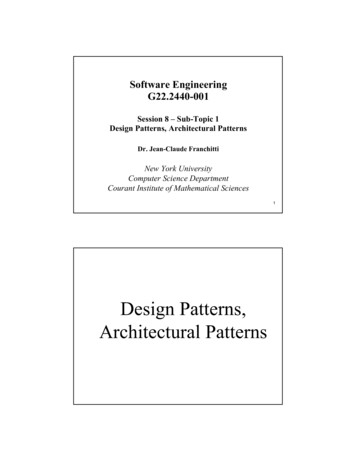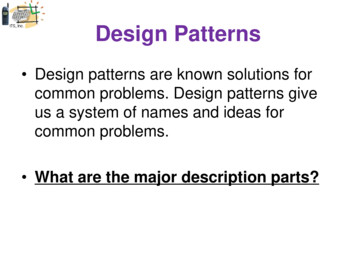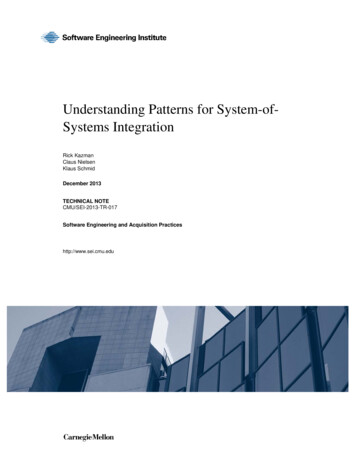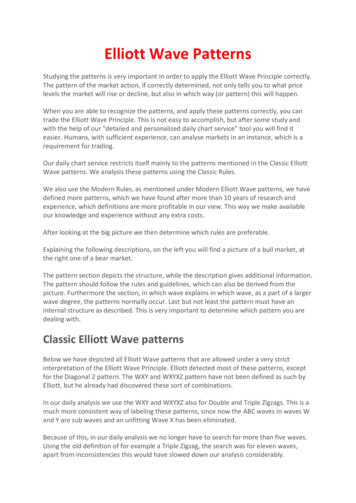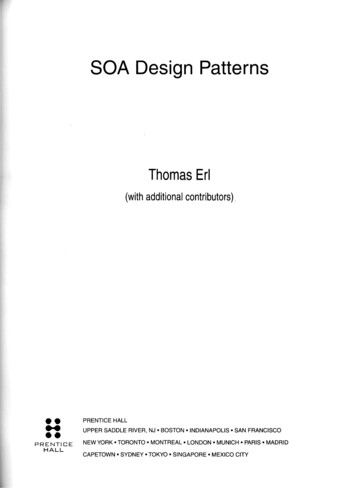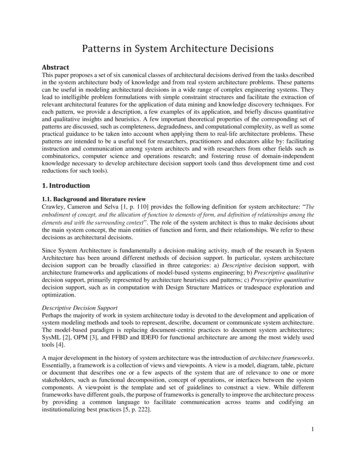
Transcription
Patterns in System Architecture DecisionsAbstractThis paper proposes a set of six canonical classes of architectural decisions derived from the tasks describedin the system architecture body of knowledge and from real system architecture problems. These patternscan be useful in modeling architectural decisions in a wide range of complex engineering systems. Theylead to intelligible problem formulations with simple constraint structures and facilitate the extraction ofrelevant architectural features for the application of data mining and knowledge discovery techniques. Foreach pattern, we provide a description, a few examples of its application, and briefly discuss quantitativeand qualitative insights and heuristics. A few important theoretical properties of the corresponding set ofpatterns are discussed, such as completeness, degradedness, and computational complexity, as well as somepractical guidance to be taken into account when applying them to real-life architecture problems. Thesepatterns are intended to be a useful tool for researchers, practitioners and educators alike by: facilitatinginstruction and communication among system architects and with researchers from other fields such ascombinatorics, computer science and operations research; and fostering reuse of domain-independentknowledge necessary to develop architecture decision support tools (and thus development time and costreductions for such tools).1. Introduction1.1. Background and literature reviewCrawley, Cameron and Selva [1, p. 110] provides the following definition for system architecture: “Theembodiment of concept, and the allocation of function to elements of form, and definition of relationships among theelements and with the surrounding context”. The role of the system architect is thus to make decisions aboutthe main system concept, the main entities of function and form, and their relationships. We refer to thesedecisions as architectural decisions.Since System Architecture is fundamentally a decision-making activity, much of the research in SystemArchitecture has been around different methods of decision support. In particular, system architecturedecision support can be broadly classified in three categories: a) Descriptive decision support, witharchitecture frameworks and applications of model-based systems engineering; b) Prescriptive qualitativedecision support, primarily represented by architecture heuristics and patterns; c) Prescriptive quantitativedecision support, such as in computation with Design Structure Matrices or tradespace exploration andoptimization.Descriptive Decision SupportPerhaps the majority of work in system architecture today is devoted to the development and application ofsystem modeling methods and tools to represent, describe, document or communicate system architecture.The model-based paradigm is replacing document-centric practices to document system architectures;SysML [2], OPM [3], and FFBD and IDEF0 for functional architecture are among the most widely usedtools [4].A major development in the history of system architecture was the introduction of architecture frameworks.Essentially, a framework is a collection of views and viewpoints. A view is a model, diagram, table, pictureor document that describes one or a few aspects of the system that are of relevance to one or morestakeholders, such as functional decomposition, concept of operations, or interfaces between the systemcomponents. A viewpoint is the template and set of guidelines to construct a view. While differentframeworks have different goals, the purpose of frameworks is generally to improve the architecture processby providing a common language to facilitate communication across teams and codifying aninstitutionalizing best practices [5, p. 222].1
While architecture frameworks are complex (e.g. DODAF 2.02 consists of 53 viewpoints) and systemsmodeling languages are expressive, they focus on describing a system with a predetermined design andarchitecture, and there is still little emphasis on the modeling of architectural and design decisions. Thepatterns presented in this paper and in particular their use in different graphical models can be seen as aformal way of defining architectural alternatives in model-based systems architecture that is moreexpressive than what exists today (e.g., SysML variants [2, pp. 128–130]).Prescriptive Qualitative Decision SupportThe foundational work that initiated the discipline of Systems Architecture is widely attributed to Rechtin[6] and Rechtin and Maier [5] later, who coined the term “systems architecting”. This early workemphasized architecting as an art, rather than a science, and focused on the use of heuristics, i.e., rules ofthumb containing simple principles or ideas that are meant to guide the architect in different phases of thearchitecture process (e.g., “In partitioning, choose the elements so that they are as independent as possible, that is,elements with low external complexity and high internal cohesion.”[5, p. 180]).A related concept that is often used in the architecture of some specific types of systems is that of patterns.A Pattern in design can be defined as the description of a conflict or situation that appears often in thedesign of a specific kind of system, such as buildings or software systems, together with a prescriptiveportion of how to solve that conflict. This is the definition that we adopt here. The value of patterns indesign is two-fold: first, they facilitate communication between designers, since they can for exampledescribe complex trade-offs succinctly by simply citing a known pattern; second, they foster reuse ofknowledge and thus can reduce the time it takes to design a system. The first use of patterns in architectingis attributed to Christopher Alexander in the domain of civil architecture. Alexander’s book “A PatternLanguage: Towns, Buildings, Construction” contains a list of 253 patterns to design anything from housesand building to towns [7]. Each pattern contains a description of the problem, conflict or situation, as wellas a proposed solution. For example, Pattern 159 “Light on each side of two rooms” states that “When theyhave a choice, people will always gravitate to those rooms which have light on two sides, and leave the rooms whichare only lit from one side unused and empty ”. Hence, the Pattern suggests to “Locate each room so that it hasoutdoor space outside it on at least two sides, and then place windows in these outdoor walls so that natural light fallsinto every room from more than one direction”. While the pattern-based approach to civil architecture washeavily criticized within the community, its impact has been undeniable in other domains, especially insoftware architecture [8].The patterns presented in this paper intend to provide similar high-level qualitative, prescriptive,experience-based decision support to system architects, focusing on the process of modeling architecturaldecisions and formulating decision problems about the system architecture. Note that this does not consistin simply removing the need for a creative and expert system architect and reducing the architecture processto a mechanistic selection and application of patterns; instead, these patterns are meant to support thearchitect and help him or her make better decisions.Prescriptive Quantitative Decision SupportMuch of the prescriptive quantitative work in System Architecture has been around Design StructureMatrices (DSM), introduced by Steward in the 1960s [9] and widely adopted both in industry and academiadue to their simplicity and modeling power [10]. DSMs are matrices that represent pairwise relationshipsbetween one or two sets of entities in a system, such as the structural relationships between the componentsof a system, or the mapping of system functions to components. While they can be used for purelydescriptive purposes, DSMs are interesting because their symbolic nature yields itself to computation. Forinstance, clustering and sequencing algorithms can be applied to DSMs in order to help system architectsfind good system decompositions or good sequences of activities [11]. Of note, the use of binary matricesto represent and analyze the structure of systems was studied in depth by Warfield, Hill, Klir, Hall, Hararyand Friedman among others during the efforts in the 1960’s and 1970’s to develop a general theory of2
systems [12]–[15]. Their work represents the foundations of much of modern systems engineering theory,including precursors to DSMs, decision networks, and activity diagrams.Another approach to quantitative decision support is based on the literature of decision analysis. Methodssuch as the Pugh matrix [16], the Analytic Hierarchy Process [17] and decision trees and networks [18] areapplicable to architectural decision making, despite some well-known criticisms related to their rigor [19]or the obvious problem of scalability to large decision spaces. Optimization-based approaches are alsocommon, in which the architecture problem is modeled through a set of variables (the architecturaldecisions) and a set of objectives (metrics that are proxies of stakeholder needs), and the goal is to find thecombination of architectural variables that maximizes values to stakeholders (or at least an architecture thatsatisfices them [20]). Other essential tools used for conducting architectural trades, such as sensitivityanalysis and design of experiments, were mostly adapted from the related fields of Engineering Design[21], [22] and Multidisciplinary Design Optimization (MDO) [23].Relatively little work has been devoted to developing decision support tools that are applicable to anydomain (e.g., automotive, aerospace), and especially tailored to the needs of system architects as opposedto lower-level design tasks. Dagli has a body of work on executable systems architecting using SysML andPetri nets [24]. Simmons developed the Architecture Decision Graph (ADG) in which the architecturaldecisions, alternatives, constraints and metrics are all represented in a single graph to show their logicalrelationships. Simmons and Koo developed a methodology to not only represent but also enumerate andevaluate architectures [25], using a modeling language based on OPM developed by Koo et al. [26].Architecture space exploration and optimization tools are complex software packages and it takessubstantial resources to develop and maintain them. The patterns presented in this paper are meant toimprove system architecture by facilitating knowledge reuse, accelerating problem formulation, andreducing the costs of developing and maintaining architecture space exploration and optimization tools.1.2 PreliminariesThe following basic terms from discrete mathematics are used in the remainder of the paper: Given twosets A and B, the Cartesian product of A and B is defined as 𝐴 𝐵 {(𝑎, 𝑏) 𝑎 𝐴, 𝑏 𝐵}. A binaryrelation from A to B is any subset of the Cartesian product: 𝑅 𝐴 𝐵. For example, if 𝐴 [𝑎1 , 𝑎2 ] and𝐵 [𝑏1 , 𝑏2 , 𝑏3 ], then the following are valid binary relations: 𝑅 {(𝑎1 , 𝑏1 ), (𝑎1 , 𝑏2 ), (𝑎2 , 𝑏3 )}, 𝑅 {(𝑎2 , 𝑏3 )}, 𝑅 { }, 𝑅 𝐴 𝐵. N-ary relations are extensions of binary relations to 𝑁 2, i.e. subsets ofthe Cartesian product 𝐴1 𝐴2 𝐴𝑁 . A binary relation on a single set A is a binary relation from A toitself: 𝑅 𝐴 𝐴. For example, the edges in a directed graph define a relation over the set of its vertices.A relation over a set 𝐴 is said to be reflexive if every element of the set belongs to it, i.e. (𝑎, 𝑎) 𝑅 𝑎 𝐴. It is said to be symmetric if (𝑎, 𝑏) 𝑅 (𝑏, 𝑎) 𝑅 and antisymmetric if (𝑎, 𝑏) 𝑅, (𝑏, 𝑎) 𝑅 𝑎 𝑏. It is said to be transitive if (𝑎, 𝑏) 𝑅, (𝑏, 𝑐) 𝑅 (𝑎, 𝑐) 𝑅. Two special kinds of relations on aset are of particular interest. A partial order relation is a relation that is reflexive, antisymmetric, andtransitive. A set with a partial order relation is called a poset. For example, the real numbers and the operator“less than or equal to” define a poset. A total order relation is a partial order relation in which either (𝑎, 𝑏) 𝑅 or (𝑏, 𝑎) 𝑅 hold. Any permutation of a set of elements defines a total order relation. An equivalencerelation is a relation that is reflexive, symmetric, and transitive. Informally, an equivalence relationdescribes elements that are similar (equivalent) according to some criterion. Elements that are equivalentare said to belong to the same equivalence class, and thus an equivalence relation partitions a set of elementsinto equivalence classes. For example, given the set of natural numbers up to 10, a possible equivalencerelation may separate odd numbers from even numbers (i.e., in a sense, this relation states that all evennumbers are equivalent and all odd numbers are equivalent, which can be seen as a description of modulo3
2 arithmetic.) Any partition of a set of elements (a grouping of its elements into mutually exclusive andcollectively exhaustive subsets) defines an equivalence relation. See [13] for an excellent introduction tothe theory of directed graphs to study systems structure.1.3. Research gap analysisModeling of architectural decisions has so far embraced the traditional approach for formulating a problemused in decision analysis and design of experiments, in which an architecture 𝑎 is represented as a set ofdecisions 𝑋 {𝑥1 , 𝑥2 , , 𝑥𝑛 }, and each decision 𝑥𝑖 has a discrete and usually small set of 𝑚𝑖 alternatives𝑂𝑖 . The architecture space is thus simply defined by the Cartesian product of all the sets of alternatives.𝑎 [𝑥1 , 𝑥2 , , 𝑥𝑛 ] 𝑥𝑖 𝑂𝑖 {𝑜𝑖1 , , 𝑜𝑖𝑚𝑖 } 𝑖 [1, 𝑛](1)𝒜 𝑂1 𝑂2 𝑂𝑛 , where 𝑂𝑖 𝑂𝑗 {(𝑎, 𝑏): 𝑎 𝑂𝑖 , 𝑏 𝑂𝑗 }For example, consider the Apollo Project case study used by Simmons to illustrate his methodology. Hisformulation consists of 𝑛 9 decisions, with a number of alternatives per decision ranging from 2 to 4, asshown in Table 1.Table 1: Decisions and sets of alternatives for the Apollo program as formulated by Simmons [25, p. 101]DecisionEarth Orbit Rendezvous (EOR)Earth Launch (EL)Lunar Orbit Rendezvous (LOR)Moon Arrival (MA)Moon Departure (MD)Crew Module Crew (CMC)Lunar Module Crew (LMC)Service Module Fuel (SMF)Lunar Module Fuel (LMF)Set of alternatives{yes, no}{orbit, direct}{yes, no}{orbit, direct}{orbit, direct}{2, 3}{0, 1, 2, 3}{cryogenic, storable}{cryogenic, storable, N/A}One architecture in this case is obtained by choosing one alternative for each decision, and thus the fullarchitecture space can be obtained by a full factorial enumeration algorithm, such as a set of nested forloops, one for each decision, or a mixed-radix generation algorithm [27]. However, some combinations ofalternatives are invalid. Indeed, the first five decisions are coupled and concern what Simmons calls themission mode of the architecture. For instance, one cannot launch direct to the Moon (EL ”direct”) and atthe same time perform an Earth Orbit Rendezvous (EOR ”yes”). This combination is logically impossibleand thus must be eliminated from the architecture space by means of constraints. There are two otherconstraints of the same kind, which together eliminate 17 out of the 32 architecture fragments determinedby the Cartesian product of the five sets of alternatives. Note that such constraints have nothing to do withthe actual problem, they are just an artifact of the formulation (there are 15, and not 32 possible differentmission modes). In fact, if we change the formulation to one that has a single mission mode decision with15 alternatives, the need for these constraints disappears. Thus, how do we choose between the twoformulations? On one hand, constraints generally add computational complexity to the optimizationproblem, since they can be seen as “dips” in the objective space that may undermine a local hill climbingprocess by the algorithm. Eliminating them will likely lead to better search performance. On the other hand,having a single decision for all the mission modes means that any information related to the sensitivity orcoupling of the mission mode decisions is hidden. Thus, the architect may actually obtain more insight byusing the formulation with more decisions.While this example based on the mission-mode decision of the Apollo project illustrates a possible tradeoff in the choice of formulation between computational efficiency and knowledge discovery, the decisionsin the Apollo program can actually be easily modeled with a formulation based on Eq. (1). Indeed, this4
approach works well for some types of architectural decisions, such as in specialization and characterizationof the functions and components of the system (e.g. the type of propellant used for each stage of eachvehicle in the system). However, it fails to adequately capture the structure of other important classes ofarchitectural decisions, in particular decisions related to system decomposition and functional allocation–two tasks that are at the core of system architecture.Consider for example the problem of architecting the US human space exploration program, tackled byRudat et al. in [28]. A simplified functional analysis reveals that the main functions to be performed by thesystem are related to the transportation of humans and cargo (essentially, performing a series of propulsivemaneuvers to travel between planetary bodies and conduct ascent and landing operations) and to habitation.One of the most important decisions to make in the system is the number of vehicles that it will have (systemdecomposition), and what functions each vehicle will do (mapping of function to form).A formulation based on Eq. (1) could consist of a decision for the number of vehicles (e.g. 1, 2, 3 or 4vehicles) plus one decision for each function that allocates it to one or more vehicles. This raises twodifficulties. First, the set of alternatives for each function depends on the number of vehicles in thearchitecture. For example, if there are two vehicles, then each function (e.g. a core propulsive maneuver)has two or three alternatives: it can either be assigned to vehicle 1, to vehicle 2, or (perhaps) to both vehicles.It cannot be assigned to any subset of vehicles containing vehicles 3 and 4, which are absent from thearchitecture. Hence, a classical decision formulation would result in many dynamic constraints to eliminatethe illogical cases – again, constraints that are an artifact of the problem formulation and could hinder bothcomputational performance and knowledge discovery. Second, the set of alternatives for a function growsexponentially with the number of vehicles, which may also lead to computational and knowledge discoverydifficulties.Summarizing, current models used to formulate architectural decisions are based on explicit enumerationof the Cartesian product of the sets of alternatives for each decision. While this works well for some typesof architectural decisions, it leads to limitations in both computational efficiency and knowledge discoverywhen applied to other important architectural decisions (e.g. system decomposition and functionalallocation). Therefore, the following research question is raised:Research Question: Is there a small set of mathematical models that combined can be used to formulate awide range of system architecture problems in a way that is understandable, computationally efficient andleads to discovery of architectural insight?2. ApproachWe attempt to find one such set of mathematical models for the research question by adopting a two-foldapproach: a) top-down, from the tasks of the system architect found in current systems architectureliterature; b) bottom-up, based on generalization from a set of real-life specific system architectureproblems.Top-down approach from the tasks of the system architectThe definition of system architecture provided in Section 1 contains the essence of the main tasks of thesystem architect: defining the main elements of form and function and their relationships, with emphasison the allocation of function to form. Many other definitions of system architecture exist: Ulrich andEppinger define it as “The arrangement of the functional elements into physical blocks” [29, p. 165]; finally, theISO/IEC 42010 standard describes it as “The set of fundamental concepts or properties of the system and itsenvironment, embodied in its elements, relationships, and the principles of its design and evolution ” [30]. Whilethese definitions are clearly different, they all highlight a few tasks of system architecture, namely thearrangement of the system into subsystems and components, the mapping of functions to these components,and the definition of interfaces between the components.5
A more detailed list of the tasks of the system architect can be found in all major textbooks in systemsarchitecture (e.g., [1], [5], [6], [31], [32]) and includes: a) defining and prioritizing system goals; b)allocating goals to solution-neutral functions; c) specializing solution-neutral functions into solutionspecific functions and decomposing functions into internal functions; d) defining functional flows andconnectivity between functions; e) mapping or allocating function to form; f) aggregating entities of form(components) into subsystems; g) characterizing (i.e. defining the attributes of) entities of form; h) defininginterfaces and connectivity between systems and subsystems; i) planning system deployment andoperations.We now focus on the aspects of these tasks that benefit from being formulated as decision making problems.Some of the previous tasks are mathematically very similar, such as allocation of goals to functions andfunction to form. If we combine mathematically akin tasks, we end up with 7 different tasks as showed inTable 2. Note that the numbers of these tasks do not necessarily imply a sequence.Table 2: Tasks of the system architect that are amenable to formulation as decision making problemsTask1. Decomposing/AggregatingForm2. Mapping Function to Form3. Specializing Form andFunction4. Characterizing Form andFunction5. Connecting Form andFunction6. Selecting Goals andFunctions7. Planning system deploymentand operationsConsists ofChoosing a system decomposition, i.e. clustering elements of form.Assigning elements of function to elements of form, or goals to functionsChoosing one among several alternatives for a certain element of Form orFunction (e.g. going from solution-neutral to solution-specific)Choosing one among several alternatives for the attributes of an elementof Form or FunctionDefining system topology and interfacesDefining scope by choosing among a set of candidate goals or functionsDefining the sequence in which technologies will be infused into theproject, system components will be deployed, or major operations will beconductedThe first task consists in the decomposition (or aggregation) of entities of form and function. Guidelines orheuristics to perform this task have been described in numerous works, such as [33], [34], [5, pp. 273–274],[32, pp. 218–220], [1, pp. 297–302]. Mathematically, this first task consists in finding an optimalpartitioning of a set of entities.The second task consists in mapping or allocating entities of one set (e.g. functions) to entities of anotherset (e.g. components). Note that the two tasks may not be independent, since function-to-form mappingmay inform system decomposition. The analysis of function-to-form mapping from the point of view offunctions and relations in set theory is the preferred approach in most of the literature [32, pp. 257–259],[35]. Mathematically, this task consists in defining an “optimal” binary relation between two sets of entities.The third and fourth tasks concern the specialization and characterization of the main entities of functionand form. Here, the terms specialization and characterization are used in the sense of OPM’s structuralrelationships [3], also described in [1, p. 48]. Specialization refers to the concretization of a general entityinto a more specific one, and typically, we will be concerned with the transition from solution-neutral tosolution-specific entities of function and form. For example, one solution-neutral function of a weathersatellite may be to take measurements of atmospheric humidity. A specialization of this function is tomeasure variations in the spectral radiance in specific portions of the infrared spectrum. Characterizationrefers to defining the value of an attribute of an entity of function or form. For example, two differentcharacterizations of the humidity sounding function can be obtained by measuring in different parts of the6
spectrum, such as infrared vs millimeter-wave. Mathematically, these two decisions are well suited for theformulation of Eq. (1).The fifth task concerns the definition of interfaces between components, once these have been selected anddefined. The connectivity task emphasizes the definition of topology in a system whose main decompositionof function and form has already been established, such as when deciding how to connect multiple fieldswith pipelines in a gas extraction system, or how to connect systems in a system-of-systems. Thisformulation appears in much of the early work in systems science and engineering [14], [36]–[38] and hasbeen considered by some authors to be the primary formulation for system design problems [39].Mathematically, the fifth task consists in finding the optimal subset of edges of a fully connected graph.The sixth task concerns the selection of the system goals. Mathematically, the sixth task consists in findingthe optimal subset among a set of entities.Finally, the seventh task consists in planning system deployment and operations. Mathematically, this taskmay consist in finding the optimal ordering of a sequence of tasks.In summary, in addition to the original formulation from Eq. (1), the following mathematical formulationsemerge from the deductive analysis: choosing among all partitions of a set of elements, among all binaryrelations between two sets of entities, among all possible orderings of a set of entities, among all possibleways of connecting a set of entities, and among all subsets of a set of entities.Bottom-up approach from examples of real-life architecture problemsIn the bottom-up approach, we list several specific examples of real-life architectural decision problemsand try to generalize the patterns that arise from them. We considered six different examples. These systemswere chosen based on actual architecture studies conducted by the authors over the years. It takes substantialtime and access to information and other resources to study the architecture of systems of this level ofcomplexity. The description of these systems below is succinct for the sake of brevity, but interested readerscan find more details about these systems and their decision formulations in our publications [40]–[44].NEOSS: Architecting the Nation’s Earth observing satellite systems: The major architectural decisions inEarth observing satellite systems are the selection of the instruments and the assignment of instruments intospacecraft and orbits [40]. For example, Envisat is a single-satellite mission in a sun-synchronous orbit at800km carrying 10 instruments including a synthetic aperture radar, a scatterometer and multiplemicrowave and infrared imagers. Another important consideration is the sequence in which the differentspacecraft are launched, since for example gaps in long data records must be avoided, and budget levelsmust be maintained.NASA GN&C family of systems: An important consideration when designing a family of GN&C systemsfor NASA to be used in a wide range of missions from Class A man-rated missions to Class C roboticspacecraft is achieving the different required levels of reliability. Reliability can be traded against mass andcost by choosing the number and type of the sensors, computers and actuators, as well as the patterns ofconnectivity between them [42].Communication systems: In the case of communication systems, some key architectural decisions concernthe selection of protocols and network functionalities to implement, the allocation of such functions tosystem components, the number, type and location of assets (e.g. ground stations, satellites, balloons,aircraft), and the selection of frequency bands and technologies (e.g. radio-frequency vs opticalcommunications) [43].Energy systems: An important architectural decision of an energy system is the types of renewable andconventional energies that are used. Given certain projections of demand, and characteristics of differentsources of energy, including efficiency, non-recurring and recurring cost, and reliability, choosing a7
portfolio will drive key decisions such as whether to build new infrastructure requiring large capitalexpenditures. Other important decisions are related to the degree of intelligence of the power distributionnetworks [44].Resource exploration systems: The architecture of a resource exploration system such as an oil platformcan be modeled as a set of fields and reservoirs connected in an oil and gas network. The number, type andlocation of the facilities as well as their pattern of connectivity are the key decisions in this case [41].When abstracted out of their domain-specific context, we observe that the decisions involved in theseproblems can be modeled using the formulations identified in the top-down approach: the originalformulation in Eq. (1) is useful for example in the selection of frequency bands in communication systemsor type of facility in resource exploration systems; the instrument packaging decision can be modeled aschoosing among all partitions of a set of elements (instruments), or choosing among all binary relationsbetween two sets of entities (instruments and orbits); the mission scheduling problem is essentially choosingamong all possible orderings of a set
in the system architecture body of knowledge and from real system architecture problems. These patterns can be useful in modeling architectural decisions in a wide range of complex engineering systems. They lead to intelligible problem formulations with simp
